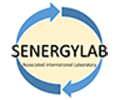You are here :
- Unité de recherche
- SenergyLab
- Home
Seminars 2021 Abstracts Seminar 2021
Prof. Christopher Arendse
« Chemical vapour deposition of Pb-halide perovskite thin films and its application in solar cells »Abstract : We demonstrate a two-step low-pressure vapour deposition of methylammonium lead iodide (MAPbI3) and mixed perovskite films in a single reactor. Continuous, polycrystalline lead iodide (PbI2) films were deposited in the first step and successfully converted to high quality perovskite films in the second step during exposure of PbI2 films to methylammonium iodide (MAI) vapor. A complete conversion was realized after 90 min of exposure with an average grain size of ~ 5 μm. The perovskite conversion starts at the PbI2 surface through the intercalation reaction of PbI2 and MAI vapor molecules and progresses toward the PbI2/substrate interface. The absorbance measurements confirmed air stability of the fully converted perovskite for 21 days, ascribed to its superior morphology and grain size. A planar single-junction perovskite solar cell with no additives or additional interfacial engineering was fabricated and tested under open-air conditions, yielding a best power conversion efficiency of 11.7%. The solar cell maintains 85% of its performance up to 13 days in the open air with a relative humidity up to 80%.

Dr Francis Muya
« Development of next generation biological sensors system as an indication of carcinogenic drugs metabolism»Abstract: Polymers material and Hydrogels have been a topic of extensive research because of their unique bulk and surface properties. They play a vital role in development of controlled release drug delivery systems. Polysulfone hydrogels are hydrophilic porous materials, which provide the advantage of biocompatibility and effective orientation of biomolecules in the design of the novel biosensors. Biosensors and sensors have also gained attention in the scientific field for their high sensitivity, specificity and easy use. Their broad applicability in medical diagnosis and innovation, food safety and drug analysis or environmental monitoring predicts their phenomenal growth. As highly sensitive, robust and accurate devices are appropriate to use in everyday analysis tasks.


Dr Keagan Popkas
« Low-cost & Disposable Paper-based Microfluidic ElectroAnalytical Devices for Priority Environmental Pollutant Detection in Resource Limited Settings»Abstract: The development of low-cost, disposable electrode materials has been at the forefront of sensor technology in recent decades. Paper, offers possibilities for multi-functional, disposable and economically friendly sensing capabilities and has proved to be a suitable reagent storage and substrate material in paper-based analytical devices (PADs). The real-time analysis offered by point-of-contamination devices are pivotal in developing areas where access to skilled labor and instrumentation is often lacking. Chelating agent based signal amplification methods in conjunction with metallic and carbon-based nanostructures have previously been employed in conjunction with electroplated metallic films to improve the electrode sensitivity in trace metal stripping analysis. In this work, an overview of our current research regarding the development of low-cost, sensitive electrochemical sensing approaches for the determination of trace metal contamination of drinking and real water samples is presented. In particular, (i) dry reagent storage approaches to prepare paper-based electrochemical cells, (ii) paper-based screen and inkjet printed electrodes and (iii) paper-based microfluidic flow/separation systems have been developed as sensing platforms for the quantitative analysis of Ni(II), based on the accumulation of Ni(dmgH)2 complexes at the modified electrode surface by square-wave adsorptive cathodic stripping voltammetry (SW-AdCSV). Furthermore, the effect of chelating agents, graphene and gold nanomaterial functionalization and ionic liquid incorporation have been studied to improve the device sensitivity by offering enhanced selectivity, electron-transfer kinetics, increased active surface area and increased catalytic properties, respectively. This study offers the first investigation on the feasibility of adsorptive electrochemical sensing methods at porous cellulose paper-based substrates. Improved sensitivities were achieved at each developed sensing device well below the EPA and WHO standards of 0.1 mg L-1 or 0.1 ppm for Ni(II) in drinking water.


